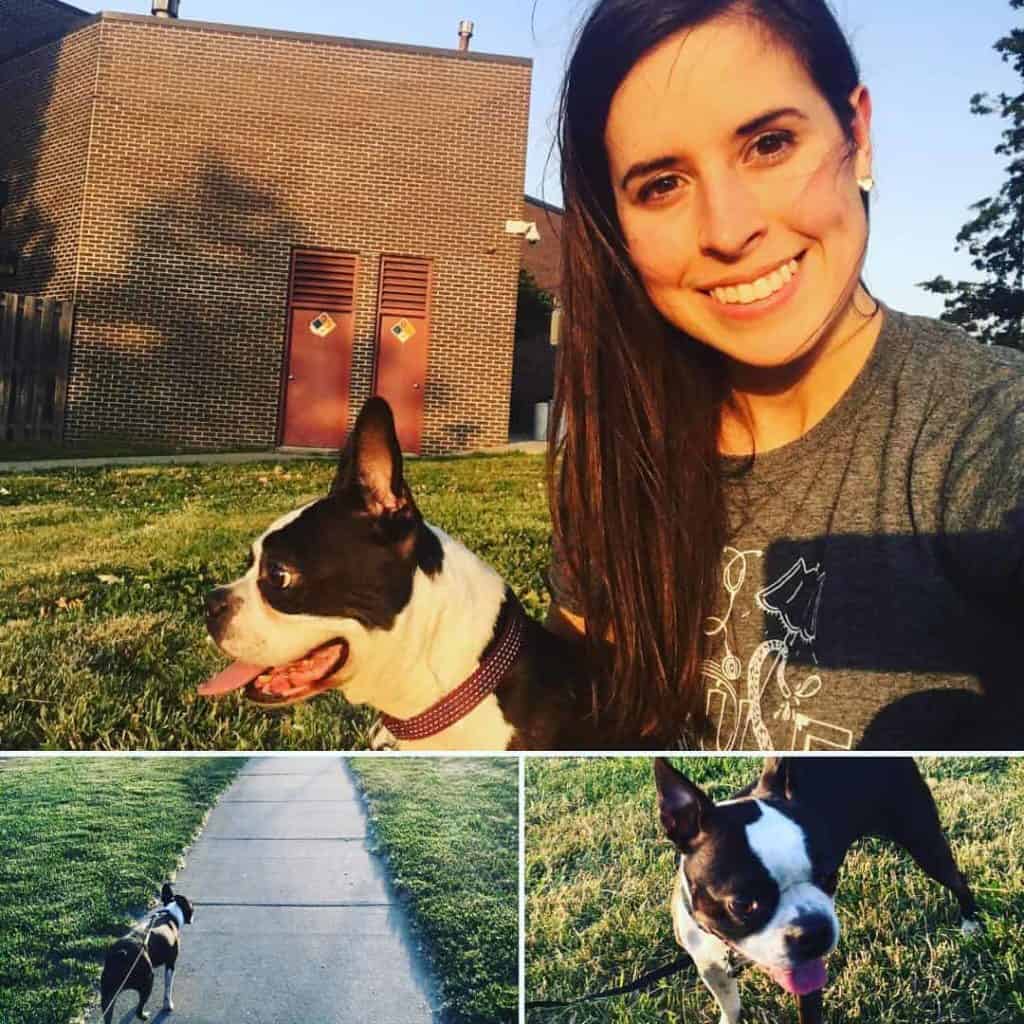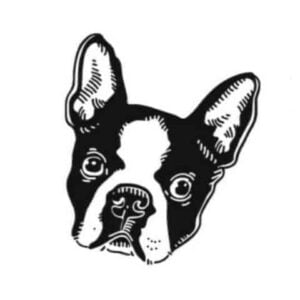Most dogs love being outdoors exploring, playing, or just relaxing on a beautiful summer day, which is why it is critical that we, as dog parents, create a safe environment for them to play in. At first glance, you may wonder what hazards are out in your yard since it looks like a fun and safe place for your dog to spend time.
Unfortunately, there is an abundance of hidden in everyday sight dangers in our yards, many of which we never realize until it’s too late. Boston Terriers are smart and energetic, so are one of those breeds that could find a fair amount of mischief if left unattended in the backyard. It takes only a second for disasters to happen, so it’s essential to do our best to put safeguards in place to avoid as many dangers as possible.

Though it is impossible to foresee all dangers in our yard, there are many preventative measures like keeping firewood away from the fence and adequately stored, keeping bird feeders at a safe distance, and keeping latches on fences to avoid escapees.
Need tips on dog-proofing your home as well? Check out my article on How to Dog Proof Your Home next.
Tips on How to Dog Proof Your Yard
It doesn’t matter if your yard is fenced in or not. All yards should be dog-proofed before bringing home your pup. However, if you don’t have a fenced in yard, it would be a good idea to install a fence if possible.
Fencing is the safest way to keep your dog contained in your yard. Also, it helps to keep other animals like other dogs, cats, deer, and coyotes out.
How to Dog Proof a Fenced in Yard
Although fencing is in itself a safety feature for your yard, it does require some maintenance to ensure it is properly keeping your canine contained.
Gaps
Look for holes at the bottom of the fence, gate, or where the gate and fence meet. Dog’s don’t need much space to contort their bodies through a small area in the fence.
Do you have gaps? You can cover up gaps at the base of the fence by using decorative fencing at the foot of your fence, eliminating the hole. If the difference between the fence and the gate using chicken coop wire can close off any problematic holes.
Gates
Adding a latch to a gate can help keep the gate from being opened by your dog. There are more than a few dogs that have been able to nose open a gate. Adding a latch will deter your pooch from opening the gate on their own.
If you are concerned about people opening the gate unexpectedly, then using a lock instead of a latch would be more effective.
Digging
Many dogs love digging and digging under a fence opens a whole new world for them. If you have a digger, it is best to attach wire fencing at the base of your fence and either bend or bury it so the dog can’t burrow underneath.
Firewood Against the Fence
It is not uncommon to find firewood stacked against the fence for storage. However, stacked wood can also make a great ramp to get over any barrier. There have been more than a few dogs that have used this escape method, even with fences as tall as six feet.
If you have firewood or other items stacked against the fence, it is best to move them to another area of the yard that your dog can’t use it as a ramp.
Also, be sure the firewood is stacked solidly as some dogs find it fun to climb on looking for critters who like to nest inside.
Invisible Fencing
Invisible fencing is an excellent way to keep your dog contained without the use of a physical fence. If you are using an invisible fence system, you will want to be sure to check the fencing and the batteries in your dog’s collar regularly.
There are times that the invisible fencing can go out or the batteries in the collar die, but routine checks will help reduce the chances of your dog from getting out.
Hazardous Pests
We share the outdoors with several wild critters such as fleas, mice, rats, deer, and coyotes. Because we aren’t able to keep all pests out of our yard, we need to use preventative measures.
Because of urban sprawl, more wildlife and pests are found in residential areas. Our world is coming in contact more frequently with the less domestic creatures in our neighborhood, the risk of infection and illness have increased.
Fleas and Ticks
Fleas and ticks are nasty nuisances that are best to be avoided when possible. Dogs can often come in contact with fleas and ticks in their backyard. There are a few preventative options we can employ to decrease the risks of your dog coming into contact with fleas and ticks.
First, using a monthly preventative such as an oral medication like Bravecto or topical treatment like Frontline (Frontline is what we have used on Bella for the last 10 years).
Second, using a flea and tick outdoor spray will reduce the flea and tick population in your yard.
Third, keeping the grass mowed and well-tended will also discourage fleas and ticks from residing in your yard.
Bird Feeders
Bird feeders attract hazardous pests such as deer, mice, rats, and rabbits. Dogs can become ill from eating wild animals, eating or coming into contact with the feces, or bites from animals with infections.
Here are some of the more prevalent problems that occur if your dog comes into contact with these critters.
Leptospirosis
Leptospirosis is a type of bacterial infection. This bacterial infection can spread from wild animals to our dogs. Dogs can contract leptospirosis if they come in contact with infected animal feces in the soil, water, or mud.
Fleas and Ticks
Fleas and Ticks commonly reside on deer and rodents, which are attracted to your yard because of the bird feeders.
Toxoplasmosis
Toxoplasmosis is a disease that is transmitted to dogs if they eat an infected rat.
If you have bird feeders is best to move them to an area of the yard that your dog cannot access.
Tie Outs
Tie outs or zip lines are commonly used when fencing isn’t an option. Tie outs are long leashes or cords that are anchored into the ground or attached to the house or deck. A zip line is like a clothesline that runs from one point to another and has a leash that rides on the line.
However, if you use a tie out, it is recommended that your dog be supervised while outside. Tie outs are dangerous to use with unsupervised dogs for two main reasons.
First, it poses a danger for strangulation.
Second, it leaves your dog vulnerable from outside threats. Dogs on tie-outs are vulnerable to attacks from other dogs or coyotes.
Poisonous Plants
Toxic plants include the plants we intentionally planted and various weeds mother nature planted; either way, all poisonous plants need to go. A list of dangerous plants is available at the ASPCA (American Society for the Prevention of Cruelty to Animals) website.
Some plants that are not toxic like poison ivy should also be removed from your yard. The oils from poison ivy can be carried on a dog’s coat and be transferred to their human family.
Dog Houses
If you have a dog that loves being outdoors, it is crucial that you provide proper shelter for your dog. Dog houses can provide shade in the summer, a dry place in the rain, and a warm cozy retreat in the colder months.
In addition to a dog house, it is vital to provide adequate fresh water. Keeping a bowl of water out for your dog is critical, but unfortunately can bring in unwanted guests like birds. Birds will commonly use large water bowls as birdbaths ultimately contaminating your dog’s water. So, it is essential to change your dog’s water frequently.
Natural Pest Controls
After discussing all of the pests that co-exist in your yard, many of us want to use pest controls to reduce the health risks, they bring with them. Prevention is critical, but using toxic poisons can backfire if your dog consumes a poisoned pest like a rabbit. The poison that was ingested by the pest can be transferred to your dog if your dog consumes the infected animal.
Choosing a natural repellent like Mouse Magic, which repels rodents using peppermint and spearmint oil is a much safer option.
Dog Collars
This is a tricky one. No one wants their dog to get out and especially not if they aren’t wearing their collar with ID tags. However, dog collars and tags do pose a strangulation threat to your pup.
During playtime, dogs have been known to get their mouth caught on the collar of their playmate. At which point, both dogs panic and struggle, making the situation worse and ultimately causing the dog with the collar on to strangle to death.
Another risk is getting the collar caught on the fence, large branch, or other immovable protrusion.
Finally, if your dog enjoys napping on the deck and the spaces between the deck boards are wide enough, your dog’s tags can fall through pinning your dog to the deck. Unfortunately, most dogs don’t wait patiently for help; instead, they panic and cause severe harm to themselves.
Keep Your Yard Clean
Keeping the yard clean of debris, trash, and dog poop is another way to keep your dog safe. Dogs like to pick things up in their mouth, and if garbage is swept into your yard by the wind, you know your dog will investigate it and possibly try eating it.
Also, keeping your yard clean of dog waste will reduce the risk of exposure to bacteria and parasites like parvo, salmonella, roundworms, coccidia, giardia, and E. coli.
Final Thoughts
Creating a safe yard for your dog is essential and can usually be accomplished easily and quickly. Many of the dangers we see in our yard are ones we can prevent, and prevention is the key to successfully keeping our pups safe. Unfortunately, our dogs don’t always make the best decisions on their own, so it is up to us to ensure our yards are kept safe for them.
Being a dog parent can seem daunting at times, but taking a few safety precautions can help to ensure we have a happy and healthy pup.
References
- Smart Dog Owners: Contagious Diseases Wildlife and Rodents Can Pass to Your Dog
- PetMD: Bacterial Infection in Dogs
- Earth Rated: Why You Should Pick Up Dog Poop
- PetMD: 5 Ways A Collar Can Harm Your Dog
- ASPCA: Poisonous Plants
